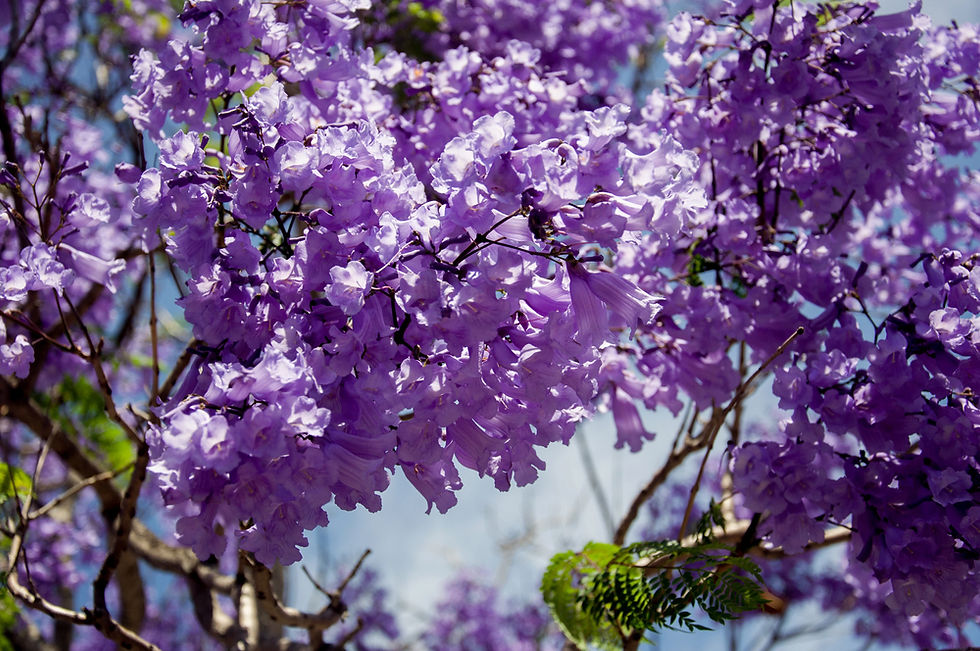Jacaranda Madness: The Purple Diva of Southern California
- Posted by A. Jordan
- Sep 16, 2025
- 3 min read
Updated: Sep 16, 2025
If you’ve ever found yourself driving through the streets of Southern California in spring, jaw dropped, eyes wide, possibly swerving a little (don’t worry, we won’t tell), you’ve probably encountered the dramatic, flamboyant, no-apologies-given Jacaranda tree.

This tree doesn’t whisper "look at me"... it SCREAMS it. And honestly, we love her for it.
Meet the Jacaranda — The Beyoncé of Trees 💜
Let’s talk about this purple powerhouse.
Scientific name: Jacaranda mimosifolia (try saying that 5 times fast)
Origin: Native to South America (specifically Argentina and Brazil), but she’s gone full Hollywood now.
Height: Up to 40 feet tall because obviously, she needs the height to command that kind of attention.
Bloom season: Late spring to early summer (but may surprise you with a second bloom in the fall—diva behavior).
Foliage: Fern-like leaves that give off delicate fairy-tale vibes.
Flowers: Trumpet-shaped, lavender-to-purple blossoms that create a literal purple carpet when they fall.
Why So Popular?
The Jacaranda has fans everywhere. Here’s why:
Aesthetic Overload: Those blooms are straight out of a dream. Instagram-worthy? Absolutely.
Sun-Lover: It thrives in SoCal’s sunshine like a true LA local.
Bee’s Bestie: Pollinators adore her. She's basically the popular girl in the pollinator yearbook.
Drama Queen: Petals everywhere. Leaves when you least expect it. She’s got moods, and we respect that.
Jacaranda TLC — Tree Loving Care
Just like any icon, the Jacaranda needs a little pampering to stay fabulous. Here’s your no-nonsense, bulletproof care guide.
Sunlight
Full sun only. Don’t even think about planting her in the shade. She’ll sulk.
Needs at least 6-8 hours of sun to put on her signature show.
Soil
Prefers well-drained, sandy soil.
Hates wet feet. If her roots sit in water too long, she’ll throw a fit (also known as root rot).
Watering
Young trees: Water deeply once a week.
Mature trees: They’re drought-tolerant but still appreciate a monthly drink in dry months.
Pro tip: Don’t overwater. She’s not a cactus, but she’s not a fish either.
Mess Factor
She’s a messy queen.
Petals will fall. Everywhere. Driveways. Lawns. That one patio chair you never sit in.
Embrace it. Maybe even make some purple confetti angels.
Fun Facts to Drop at Parties (Tree Parties, Obviously)
Some people call her the “Blue Trumpet Tree,” even though she’s clearly purple. (We don’t get it either.)
In Australia, Jacaranda trees are used as graduation season indicators. If the blooms fall and you haven’t started studying…too late. You’re doomed. (Just kidding… sort of.)
Bees make purple-tinged honey from Jacaranda nectar.
Final Thought: To Plant or Not to Plant?
If you love beauty, drama, and don’t mind a bit of a mess, the Jacaranda is your perfect match. She’s the Marilyn Monroe of trees — breathtaking, bold, and always stealing the scene.
Just be ready to commit. She’ll reward you with decades of show-stopping bloomage and poetic purple rain.
So go ahead, plant that Jacaranda. Just don’t blame us when your neighbors get jealous and start naming their trees too.
From your favorite tree nerds at Sims Tree Learning Center, where roots run deep, and so does our love for all things leafy.
About Sims Tree Health Specialists, Inc.
Sims Tree Health Specialists, Inc. is dedicated to the preservation, education, improved health, and safety of trees. Sims THS has provided California’s Urban Forests with premium healthcare since 1972. To learn more, visit our website: https://www.simsths.com/
Sims THS offers services with our ISA Certified Arborists in the following:
Diagnosis and Disease Management, Pest Suppression, Organic Solutions, Fruit Suppression, Drought Protection, and Arborist Assessment Reports and Preservation Plans.
In addition to providing quality tree health services, the Sims family is known for their educational pursuits. In 1996, they started the Sims Tree Learning Center (TLC), a 6-acre botanical garden and research facility sponsored by Sims Tree Health Specialists, Inc. The facility houses multiple types of gardens including a cactus and succulent garden and one of the largest collections of Palms in the Inland Empire. Learn with us!



Comments